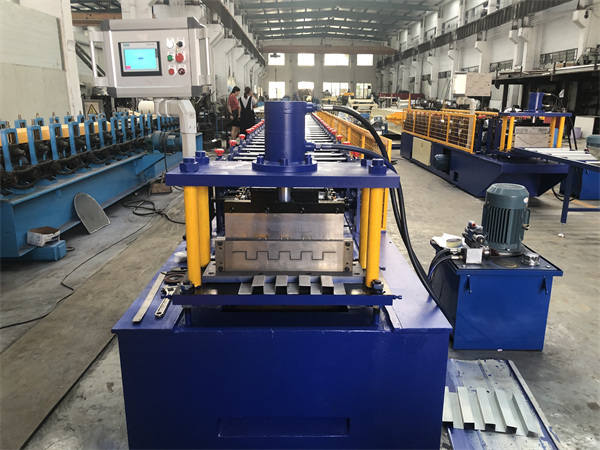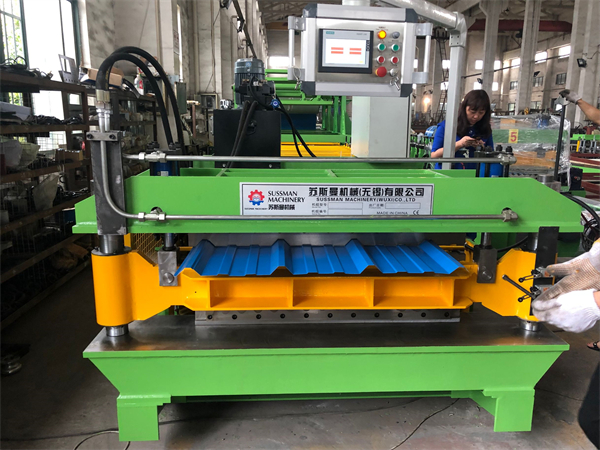1 परिचय
When it comes to the production of various metal components with high precision and efficiency, the Filo Steel Roll Forming Machine stands out as a top-notch solution. In this article, we will explore the world of Filo Steel Roll Forming Machines, diving into their working principle, benefits, components, operation, applications, and future trends. Whether you are an industry professional or a curious enthusiast, join us as we unravel the fascinating technology behind these machines.
2. What is a Filo Steel Roll Forming Machine?
A Filo Steel Roll Forming Machine is an advanced piece of equipment used in metalworking and fabrication processes. It utilizes a continuous bending operation to shape long strips of coiled steel, also known as coils, into desired profiles and cross-sections. The process is efficient and cost-effective, making it an attractive choice for various industries.
3. The Working Principle of Filo Steel Roll Forming Machine
The working principle of a Filo Steel Roll Forming Machine is based on sequential roller die sets. As the steel strip passes through these die sets, it gradually takes the desired shape. Each roll station is carefully designed to bend the material slightly, contributing to the final form. The process continues until the strip achieves the intended shape, with each roll station playing a specific role in the overall transformation.

4. Benefits of Using a Filo Steel Roll Forming Machine
Using a Filo Steel Roll Forming Machine offers numerous advantages over traditional metalworking methods. Some of the key benefits include:
- High Efficiency and Productivity
- Consistent and Precise Output
- Material and Cost Savings
- Versatile and Customizable Designs
- Reduced Waste and Environmental Impact
5. Types of Filo Steel Roll Forming Machines
Filo Steel Roll Forming Machines come in various types, each suited for different production needs. The main types include:
1. Single Stand Filo Steel Roll Forming Machine
The single stand machine is suitable for simple profiles that do not require complex shapes. It consists of one set of roll stations and is commonly used in basic applications.
2. Double Stand Filo Steel Roll Forming Machine
The double stand machine features two sets of roll stations, allowing for more intricate shapes and profiles. It offers increased flexibility and versatility in production.
3. Multi-stand Filo Steel Roll Forming Machine
The multi-stand machine is the most advanced and versatile option. With multiple roll stations, it can produce complex profiles and cross-sections with high precision and speed.
6. Components of a Filo Steel Roll Forming Machine
A typical Filo Steel Roll Forming Machine comprises several essential components that work together to achieve the desired results. These components include:
6.1 Entry Section
The entry section is responsible for feeding the coiled steel strip into the machine and preparing it for the roll forming process.
6.2 Roll Forming Section
The roll forming section consists of the sequential roller die sets responsible for bending the steel strip into the desired shape.
6.3 Cutting Section
The cutting section is where the formed profiles are cut to the required length.
6.4 Exit Section
The exit section facilitates the smooth egress of the finished products.

7. How to Operate a Filo Steel Roll Forming Machine
Operating a Filo Steel Roll Forming Machine efficiently requires a systematic approach and attention to detail. Here are the key steps involved in operating the machine:
7.1 Machine Setup and Preparation
Before starting the machine, ensure it is properly set up and calibrated according to the required specifications.
7.2 Material Loading and Feeding
Load the coiled steel strip onto the machine, ensuring it feeds smoothly through the entry section.
7.3 Adjusting Roll Forming Parameters
Adjust the roll forming parameters, such as roll speeds and pressures, to achieve the desired profile.
7.4 Monitoring the Process
Monitor the machine’s operation regularly to identify any issues or deviations from the desired outcome.
7.5 Quality Control and Inspection
Perform quality control checks and inspections on the finished products to ensure they meet the required standards.
8. Maintenance and Safety Tips for Filo Steel Roll Forming Machines
Maintaining a Filo Steel Roll Forming Machine is crucial to ensure its optimal performance and longevity. Additionally, safety measures must be followed to protect operators and prevent accidents. Here are some maintenance and safety tips:
8.1 Regular Maintenance Routine
Implement a regular maintenance schedule, including cleaning, lubrication, and inspection of critical components.
8.2 Lubrication and Cleaning
Keep the machine well-lubricated and clean to reduce wear and tear and prevent the buildup of debris.
8.3 Safety Measures
Follow all safety protocols, including wearing appropriate personal protective equipment and adhering to operating guidelines.
9. Applications of Filo Steel Roll Forming Machines
Filo Steel Roll Forming Machines find extensive applications in various industries, including:
9.1 Construction Industry
In construction, these machines produce profiles used in roofing, wall cladding, and structural components.
9.2 Automotive Industry
The automotive sector relies on Filo Steel Roll Forming Machines to create various components for vehicles.
9.3 Electrical Industry
In the electrical industry, these machines produce parts used in cable trays, conduit systems, and electrical enclosures.
9.4 Furniture Manufacturing
Furniture manufacturers utilize these machines to create customized metal profiles for various furniture pieces.

10. Future Trends in Filo Steel Roll Forming Technology
The world of Filo Steel Roll Forming is continuously evolving, with technological advancements shaping its future. Here are some key trends that are expected to impact the industry:
10.1 Automation and Industry 4.0 Integration
Automation is playing a significant role in modern manufacturing, and the Filo Steel Roll Forming industry is no exception. Manufacturers are integrating Industry 4.0 principles to improve production efficiency, reduce downtime, and enhance product quality. Advanced sensors and data analytics enable real-time monitoring and predictive maintenance, ensuring optimal performance and minimizing production disruptions.
10.2 Advanced Materials and Composites
As demands for lightweight and high-strength components increase, the use of advanced materials and composites in roll forming is gaining momentum. Manufacturers are exploring innovative materials to create stronger and more durable profiles while maintaining cost-effectiveness. This trend is particularly prevalent in industries like aerospace and transportation.
10.3 Customization and Personalization
Consumer preferences are shifting towards personalized products, and the Filo Steel Roll Forming industry is responding to this demand. Advanced roll forming machines equipped with computer numerical control (CNC) capabilities allow for rapid prototyping and quick changes in profile designs. Customization options enable manufacturers to cater to individual needs and create unique solutions for different applications.
10.4 Green and Sustainable Initiatives
With a growing focus on sustainability and environmental responsibility, the Filo Steel Roll Forming industry is embracing greener practices. Manufacturers are adopting energy-efficient technologies and exploring recyclable and eco-friendly materials. By minimizing waste and energy consumption, the industry aims to reduce its carbon footprint and contribute to a cleaner future.
10.5 Integration of Additive Manufacturing
Additive manufacturing, commonly known as 3D printing, is increasingly being integrated into traditional roll forming processes. By combining the strengths of both technologies, manufacturers can create complex shapes and structures with improved precision and reduced material waste. This integration opens up new possibilities for designing intricate profiles with enhanced functionality.
11. Choosing the Right Filo Steel Roll Forming Machine
Selecting the appropriate Filo Steel Roll Forming Machine is crucial for achieving the desired production outcomes. Consider the following factors when making your decision:
11.1 Consideration Factors
- Production Requirements: Assess the volume and complexity of the profiles you need to produce to determine the machine’s capacity.
- सामग्री संगतता: Ensure the machine is compatible with the types of materials you plan to use, whether it’s steel, aluminum, or other alloys.
- अनुकूलन विकल्प: If you require flexibility in profile designs, opt for a machine with easy customization features.
- Budget and Return on Investment: Analyze the cost of the machine and the potential return on investment based on your production needs.
11.2 Budget and Cost Analysis
While cost is an important consideration, it’s essential to strike a balance between budget constraints and machine quality. Opting for a machine solely based on the lowest price may compromise performance and long-term reliability. Invest in a reputable brand known for producing reliable and high-quality machines, even if it requires a slightly higher initial investment.

12. Conclusion
The Filo Steel Roll Forming Machine has revolutionized metal fabrication, offering efficient and precise manufacturing solutions across various industries. Its continuous bending process ensures consistent profiles with minimal material waste, making it an attractive choice for modern manufacturing needs. As the industry embraces automation, customization, and sustainability, the future of Filo Steel Roll Forming holds exciting prospects.
Whether you’re a seasoned professional or an enthusiastic beginner, exploring the world of Filo Steel Roll Forming is an adventure worth undertaking. Embrace the technology, innovate with new materials, and choose the right machine to take your production capabilities to new heights.
पूछे जाने वाले प्रश्न
1. How does a Filo Steel Roll Forming Machine work? A Filo Steel Roll Forming Machine utilizes sequential roller die sets to bend long strips of coiled steel into desired profiles and cross-sections.
2. What are the benefits of using a Filo Steel Roll Forming Machine? The benefits include high efficiency, precise output, material and cost savings, versatility in designs, and reduced environmental impact.
3. What types of Filo Steel Roll Forming Machines are available? There are single stand, double stand, and multi-stand machines, each offering different levels of complexity and versatility.
4. What industries use Filo Steel Roll Forming Machines? These machines find applications in construction, automotive, electrical, and furniture manufacturing industries.
5. How is Filo Steel Roll Forming technology evolving? The industry is moving towards automation, advanced materials, customization, sustainability, and integration with additive manufacturing techniques.
